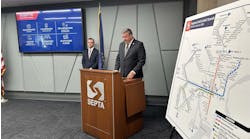City of Albuquerque, L.A. Metro, Santa Clara VTA seeing ridership increase
The city of Albuquerque, N.M., the Los Angeles County Metropolitan Transportation Authority (L.A. Metro) and the Santa Clara Valley Transportation Authority (VTA) have all seen ridership increases on its various systems during the past few months.
City of Albuquerque
The city’s ABQ Ride saw ridership reached 645,974 in July and 667,727 in August 2024, respectively, – its highest numbers since March 2020 at 630,292 when the COVID-19 pandemic began. The data comes from new automatic passenger counters (APCs) ABQ Ride has replaced old fareboxes with.
“Getting this more accurate picture of how many folks are actively using our transit system will allow us to further improve service, safety and efficiency,” said City of Albuquerque Mayor Tim Keller. “The fact there are so many choosing to ride our city’s buses shows we’re on the right track to building back our transit system.”
The city says that when it purchased the Albuquerque Bus Company in 1964, founding ABQ RIDE, the transit system featured metal boxes next to the driver to collect bus fare. The fareboxes were manually emptied each day by a Vault Puller and in recent years, fareboxes counted passengers upon collection. Since the implementation of Zero Fares, ABQ RIDE has relied on manual driver counts of passengers.
“ABQ RIDE is ahead of the curve with a frictionless Zero Fares system,” said City of Albuquerque Transit Director Leslie Keener. “With fareboxes no longer necessary, we have an opportunity to improve ridership data quality by taking out the margin of human error through digitization of our system.”
Since 2019, ART buses have had APCs. Now, the city says the technology is providing data across ABQ RIDE’s fleet and APCs provide the official data source for ridership that is submitted to the Federal Transportation Administration (FTA) for annual funding. The APCs detect the shape of people coming in and out of the doors above every door. The city notes the technology improves data quality and efficiency in gathering ridership data.
ABQ RIDE is currently running at two-thirds of service. Despite the reduction, the city says the service is as productive per vehicle hour as it was before the COVID-19 pandemic. The city notes the increased ridership puts a strain on current staffing resources and illustrates the continued need to hire drivers and mechanics. ABQ RIDE will return to full service as soon as ABQ RIDE closes the gap in hiring.
L.A. Metro
August saw L.A. Metro achieve its 21st consecutive month of year-over-year ridership growth with 27.1 million boardings, reaching 84 percent of its August 2019 pre-COVID-19 ridership level. Total weekday boardings were 21.2 million, reaching 82.3 percent of its pre-COVID-19 pandemic August 2019 level. The agency notes total August weekends saw 5.9 million boardings, reaching 94.9 percent of pre-COVID-19 pandemic weekend ridership compared to August 2019.
Bus ridership
According to L.A. Metro, bus ridership grew again in August with 21.1 million rides taken, marking an 8.2 percent year-over-year ridership increase compared to August 2023 ridership, which is 85.8 percent of its August 2019 level. L.A. Metro recorded 16.7 million bus boardings on weekdays in August while Saturdays saw 2.7 million boardings and Sundays had 1.8 million boardings in August. The agency notes weekend bus ridership is now at 93 percent of its pre-COVID-19 pandemic level.
Rail ridership
In August, L.A. Metro says rail boardings were 5.9 million, reflecting a gain of 2.5 percent compared to August 2023 ridership and an 81.3 percent recovery of August 2019 rail ridership. Weekday rail boardings were 4.5 million trips taken, reflecting 76.6 percent of weekday rail boardings in August 2019.
The agency says August marked the second full month of year-over-year ridership comparison for the A and E lines. Ridership grew 13.2 percent year-over-year compared to August 2023. The agency notes that Individually, the A Line grew 15.6 percent when compared to ridership in August 2023 and the E Line grew 10.1 percent year-over-year. In August, the A Line surpassed the B Line as the busiest rail line in the system with 1.9 million trips taken.
Leisure ridership
In August, L.A. Metro provided special event support to nearly 50 transit-accessible events at large venues and entertainment parks in the L.A. region. The agency also provided special event parking at several of its stations for event goers to park and ride. In August, parking at L.A. Metro’s C line Crenshaw Station saw a 10 percent increase in weekend parking utilization as patrons parked, rode transit and used the agency’s shuttle to Sofi Stadium and Kia Forum.
L.A. Metro notes leisure rides continue to be a driver of overall ridership growth, especially on the weekends. In August, weekend rail ridership in August surpassed its August 2019 pre-COVID-19 pandemic ridership by 1.3 percent and weekend bus ridership was at 93 percent of its pre-COVID-19 pandemic level.
Fare programs
L.A. Metro continues to provide programs that make riding more affordable for everyone. The agency’s reduced-price transit pass programs, such as the student GoPass program, which offers free transit passes to K-12 and community college students, and its Low-Income Fare is Easy (LIFE) program, which provides free rides and reduced fares to low-income customers, are helping those who need it most.
In August, L.A. Metro’s GoPass Program had 937,551 boardings, an 18 percent year-over-year increase compared to August 2023. GoPass welcomed six new schools that joined the program in August – Valley Charter, St Mary’s Academy, Options for Youth – San Gabriel, Global Education Academy, Debbie Allen Dance Academy and Ahava Academy.
The agency notes LIFE program boardings are up five percent year-over-year in August 2024 with 1.7 million boardings. During August, the LIFE team held more than 85 in-person enrollment events to sign eligible people up for the reduced fare program.
Public safety on L.A. Metro
The agency continues to increase its work to improve public safety with a three-point plan:
- Keep its employees and customers safe and ensure they feel safe through an increased visible presence of uniformed personnel, station improvements and improved bus safety measures
- Ensure the system is being used only for its intended purpose of transit through fare gate improvements and removal of trespassers
- Continue to partner with the county, the cities and regional agencies to address societal issues such as homelessness, untreated mental illness and drug addiction.
As part of the strategy, L.A. Metro’s law enforcement partners have expanded their visible presence on the rail system and more Transit Security Officers have been added to enforce L.A. Metro’s Customer Code of Conduct rules on both the bus and rail system. L.A. Metro Transit Security Bus Safety Teams performed end-of-line operations during late-night “Owl” service on some of the busiest bus lines. L.A. Metro Ambassadors are also out in force on L.A. Metro’s six rail lines and five of the busiest bus lines to provide support to customers.
Santa Clara VTA
September 2024 was the first month since March 2020 in which Santa Clara VTA had seen 100,000-plus riders on multiple days of service. The milestone occurred on 10 separate weekdays, with the most recent one being Sept. 19 when Santa Clara VTA helped a total of 102,231 riders get to and from their destinations throughout Santa Clara County.
Santa Clara VTA says the trend is due to high schools and local colleges returning to session, scheduled events at Levi Stadium and rising demand from workers. The agency notes more people are also traveling during off-peak hours, specifically during the midday, evening and weekends.
In response to the increase in ridership, Santa Clara VTA has several proposals to help respond to ridership. On Oct. 28, the agency will be restoring Routes 31, 37, 55 and 83 to full service as adopted in the 2024 Transit Service Plan. Additionally, Santa Clara VTA will consider frequency improvements and additional service hours for next year.

Brandon Lewis | Associate Editor
Brandon Lewis is a recent graduate of Kent State University with a bachelor’s degree in journalism. Lewis is a former freelance editorial assistant at Vehicle Service Pros in Endeavor Business Media’s Vehicle Repair Group. Lewis brings his knowledge of web managing, copyediting and SEO practices to Mass Transit Magazine as an associate editor. He is also a co-host of the Infrastructure Technology Podcast.






